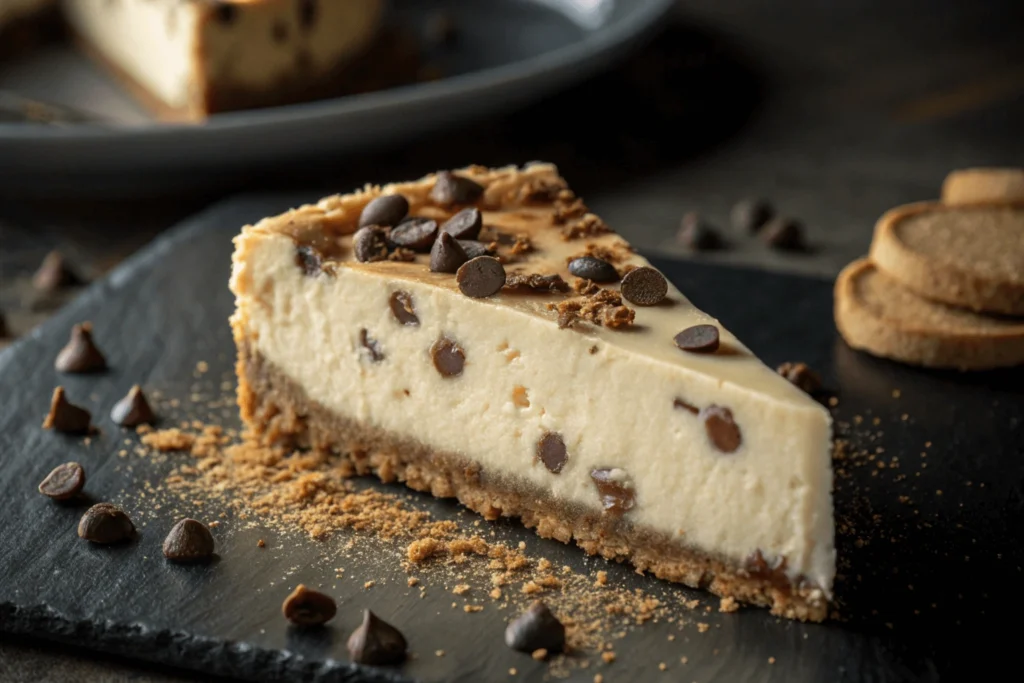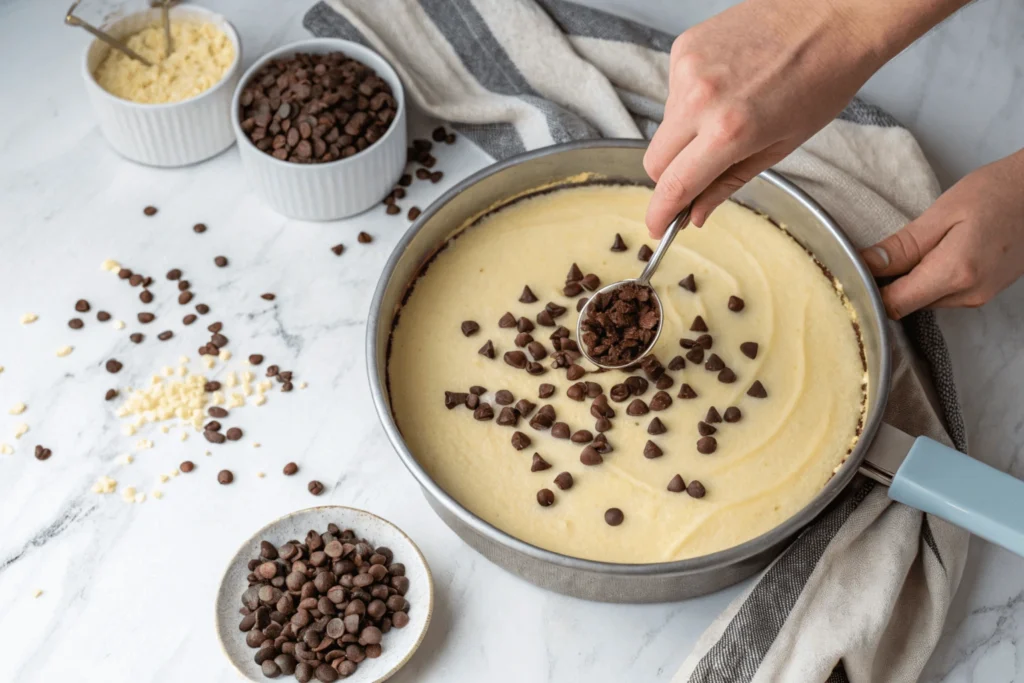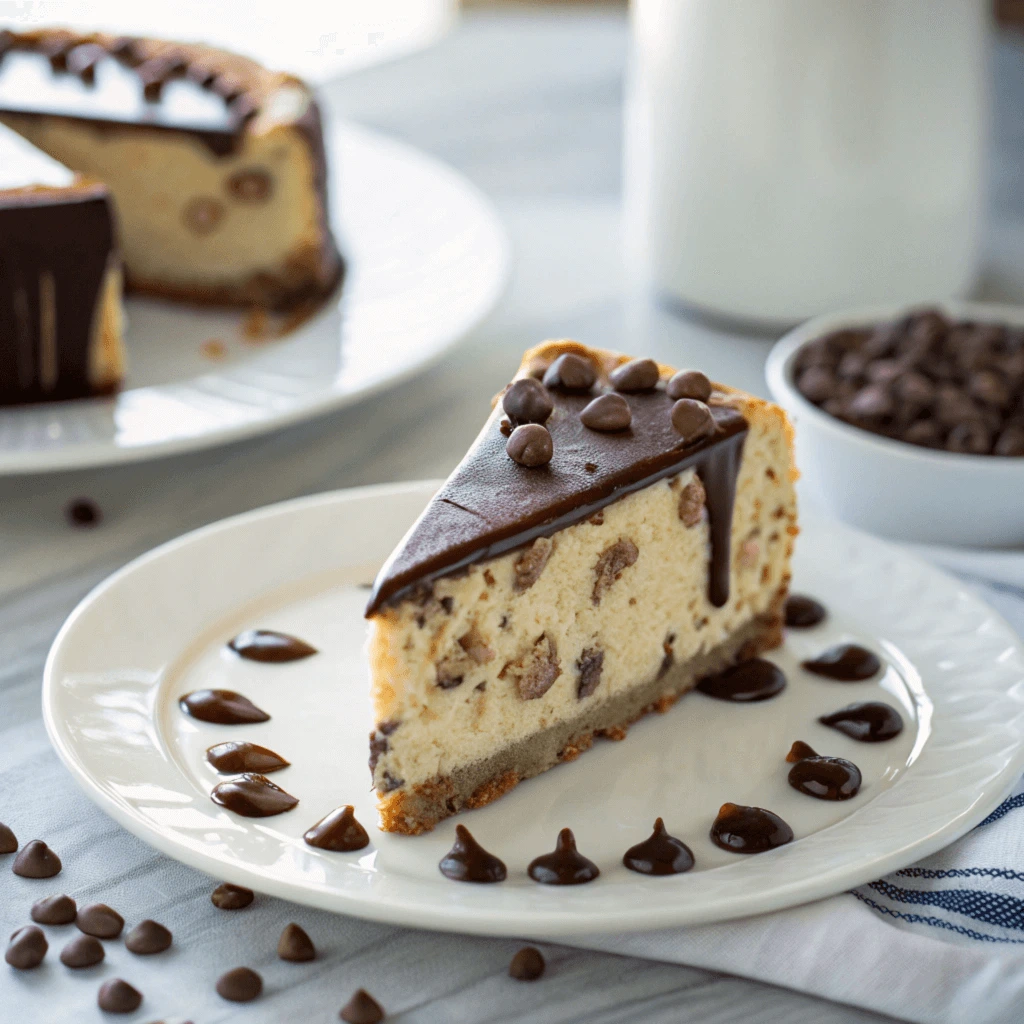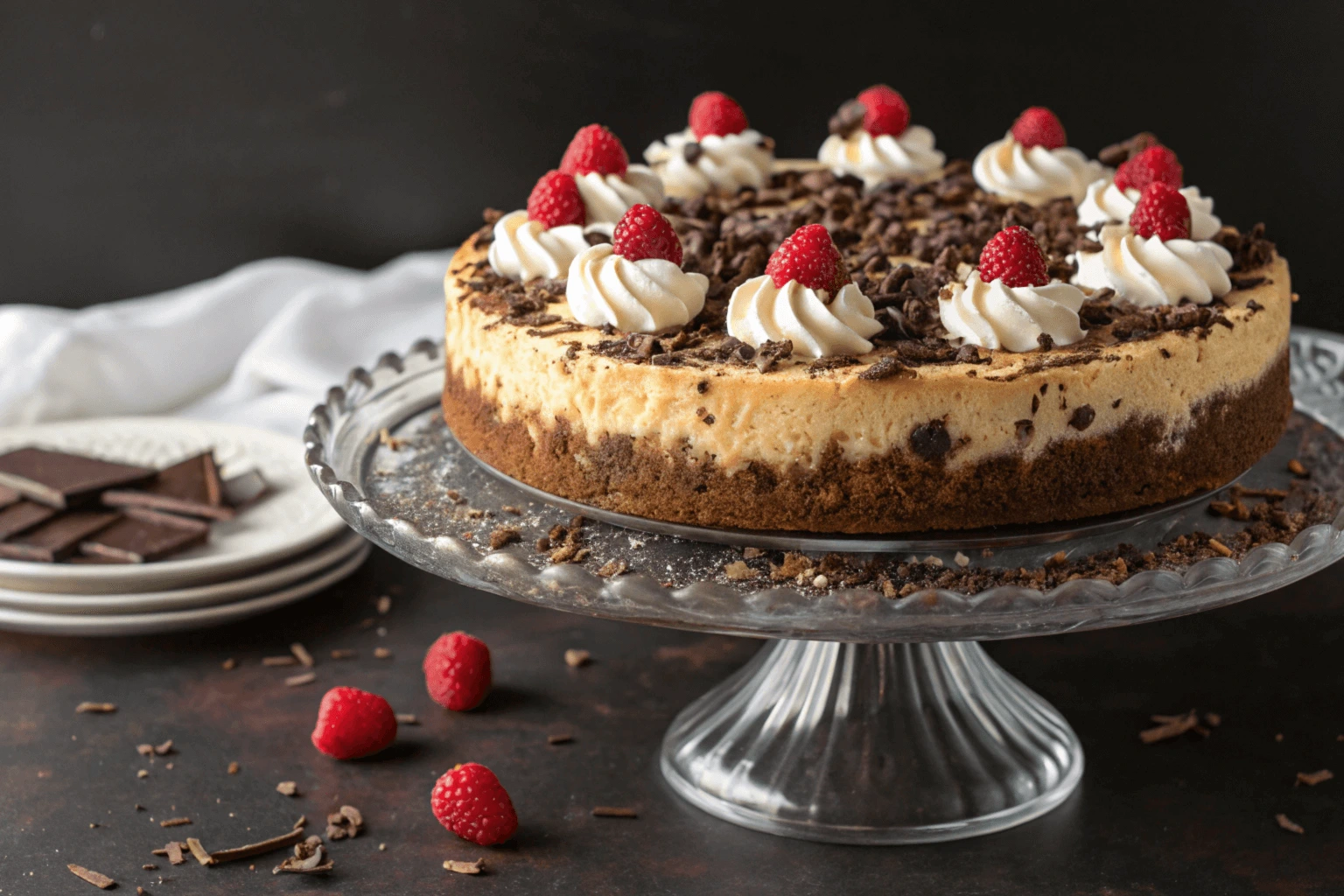Table of Contents
Why Chocolate Chip Cheesecake is the Ultimate Dessert
If you’re a fan of decadent desserts, there’s nothing quite like a slice of chocolate chip cheesecake. Combining the creamy richness of a classic cheesecake with the irresistible sweetness of chocolate chips, this dessert strikes the perfect balance between indulgence and comfort. Whether you’re hosting a special gathering or simply craving something sweet at home, chocolate chip cheesecake is a crowd-pleaser that never goes out of style.
Making this dessert from scratch is easier than you might think, and the result is always a showstopper. With a buttery graham cracker crust, a smooth and velvety filling, and a generous sprinkle of chocolate chips throughout, each bite is a delightful treat. In this guide, we’ll walk you through the simple steps to create the best chocolate chip cheesecake at home, along with some tips to ensure it turns out perfect every time.

RELATED : Cookie Monster Ice Cream
Key Ingredients for the Best Chocolate Chip Cheesecake
The Role of Premium Cream Cheese
- Philadelphia-style cream cheese provides optimal smoothness and tang
- Room temperature cream cheese prevents lumps and ensures even mixing
- Full-fat varieties deliver superior richness and stable texture
- Proper softening technique: 1 hour at room temperature
Selecting the Perfect Chocolate Chips
- Semi-sweet (60-70% cacao): Balanced flavor, best melting properties
- Dark chocolate: Intense flavor, less sweetness, sophisticated profile
- Mini chips: Better distribution throughout batter
- High-quality brands: Ghirardelli, Guittard, or Callebaut recommended
Crafting the Ultimate Graham Cracker Base
- Fresh graham crackers for best flavor
- Proper butter-to-crumb ratio (1/2 cup butter per 1.5 cups crumbs)
- Fine, even crushing technique
- Pre-baking method (10 minutes at 350°F)
Essential Supporting Ingredients
- Fine sea salt: Flavor enhancement
- Large eggs: Structure and richness
- Pure vanilla extract: Depth of flavor
- Granulated sugar: Sweetness balance
- Sour cream: Moisture and tanginess
- Heavy cream: Silky texture
Chocolate Chip Cheesecake Ingredients
| Ingredient | Amount | Notes |
|---|---|---|
| Crust | ||
| Graham crackers | 1½ cups | Finely crushed |
| Butter | ½ cup | Melted |
| Sugar | ¼ cup | Granulated |
| Filling | ||
| Cream cheese | 24 oz (3 blocks) | Room temperature, full-fat |
| Sugar | 1 cup | Granulated |
| Eggs | 3 large | Room temperature |
| Heavy cream | ½ cup | Room temperature |
| Sour cream | ¼ cup | Room temperature |
| Vanilla extract | 1 tablespoon | Pure |
| Chocolate chips | 1½ cups | Semi-sweet or dark |
| Salt | ¼ teaspoon | Fine sea salt |
For the best results, ensure all ingredients are at room temperature.
Step-by-Step Guide to Making Your Chocolate Chip Cheesecake
Prepare the Crust: Instructions on Making the Graham Cracker Crust
The graham cracker crust is the foundation of your chocolate chip cheesecake, providing the perfect balance of crunch and sweetness to complement the creamy filling. A well-prepared crust not only adds texture but also enhances the overall flavor of the dessert. Here’s how to make a simple, yet delicious graham cracker crust for your cheesecake.
Ingredients for the Graham Cracker Crust:
To make the crust, you’ll need just a few basic ingredients:
- Graham crackers (about 10-12 full crackers, crushed into crumbs)
- Butter (unsalted, about 6 tablespoons, melted)
- Sugar (optional, about 2 tablespoons, depending on your sweetness preference)
- Salt (a pinch, if you like a contrast to the sweetness)
Step-by-Step Instructions:
- Crush the Graham Crackers: Start by breaking the graham crackers into smaller pieces and placing them in a food processor. Pulse them until they turn into fine crumbs. If you don’t have a food processor, you can place the crackers in a resealable plastic bag and crush them with a rolling pin. The key is to get the crumbs fine and consistent in size to create a smooth crust.
- Combine the Ingredients: In a mixing bowl, combine the graham cracker crumbs, sugar (if using), and a pinch of salt. Mix these dry ingredients together before adding the melted butter. The butter is what binds the crumbs together and helps form the crust when baked.
- Add the Butter: Pour the melted butter into the dry graham cracker mixture and stir it well until all the crumbs are evenly coated. The mixture should resemble the consistency of damp sand. If it feels too dry, you can add a little more melted butter, a tablespoon at a time, until you reach the desired consistency.
- Press the Crust into the Pan: Choose a springform pan for easy removal of the cheesecake once it’s done. Press the graham cracker mixture firmly into the bottom of the pan, ensuring it’s even and compact. Use the back of a spoon or a measuring cup to press the crumbs down tightly. If you like a thicker crust, you can also press the mixture slightly up the sides of the pan to create a more defined edge.
- Bake the Crust: Preheat your oven to 350°F (175°C). Once the crust is pressed into the pan, bake it for 8-10 minutes to set it. This baking step helps to solidify the crust and gives it a golden, slightly crisp texture. Keep an eye on it to avoid overbaking. Once it’s done, remove it from the oven and allow it to cool completely before adding the cheesecake filling. Cooling the crust helps prevent the filling from melting into it while baking.
Optional Variations:
- Chocolate Crust: For a richer flavor, add a tablespoon or two of unsweetened cocoa powder to the graham cracker crumbs before mixing in the butter.
- Nutty Twist: You can also add finely chopped nuts, such as pecans or almonds, to the graham cracker crumbs to add an extra layer of flavor and crunch.
- Spiced Crust: For a slightly spiced flavor, add a pinch of cinnamon or pumpkin spice to the graham cracker mixture.
Tips for a Perfect Crust:
Use the Right Pan: A springform pan is highly recommended for cheesecakes as it allows easy removal and keeps the crust intact.
Press it Firmly: Make sure to pack the crumbs tightly into the pan. A loose crust can crumble when slicing the cheesecake.
Cool Completely: Never add the cheesecake filling to a warm crust, as it can affect the texture. Be patient and let it cool fully before filling.
-This section explains how to create a graham cracker crust step by step, while offering tips and optional variations to personalize your cheesecake base.
Mixing the Cheesecake Filling: How to Create a Smooth, Creamy Filling with Chocolate Chips
The filling is the heart of any cheesecake, and when it comes to chocolate chip cheesecake, achieving a smooth, creamy, and well-blended filling is essential for a rich, velvety texture. Properly mixing the cheesecake batter is key to avoiding lumps and ensuring the perfect consistency, while also incorporating the chocolate chips in a way that allows them to blend seamlessly into the filling. Here’s how to create that irresistible, smooth cheesecake filling every time.
Step 1: Start with Softened Ingredients
For a flawless cheesecake filling, always ensure that your cream cheese, eggs, and sour cream (if used) are at room temperature. This helps them blend more easily and prevents any lumps from forming. Cold ingredients can cause the cream cheese to seize up and create an uneven mixture, so take a few minutes before mixing to allow them to warm up. Softened ingredients mix together smoothly, yielding a silky batter that bakes to perfection.
Step 2: Beat the Cream Cheese Until Smooth
The first step in creating the filling is to beat the softened cream cheese on medium speed using an electric mixer until it’s completely smooth. This ensures that no lumps remain, giving you that desirable creamy texture. If you skip this step or don’t beat the cream cheese long enough, your filling could end up lumpy, compromising the cheesecake’s overall mouthfeel. Take your time and make sure the cream cheese is completely smooth before moving to the next step.
Step 3: Gradually Add the Sugar
Once the cream cheese is smooth, add the granulated sugar in small batches. This helps to dissolve the sugar evenly, preventing a grainy texture. Continue to mix until the batter is light and fluffy. The sugar also helps to balance out the tanginess of the cream cheese, contributing to the overall sweetness of the cheesecake without overpowering it.
Step 4: Add the Eggs Slowly, One by One
Adding the eggs one at a time is crucial to avoid overmixing, which can cause the cheesecake to crack during baking. Ensure each egg is fully incorporated before adding the next. This ensures that the eggs are evenly distributed throughout the batter, which helps create a smooth, stable filling. Overmixing can introduce excess air into the batter, which may lead to cracks as the cheesecake bakes and cools.
Step 5: Add Flavor and Creaminess with Vanilla and Sour Cream (Optional)
For extra depth of flavor, add a splash of vanilla extract to your cheesecake filling. This enhances the overall sweetness and complements the rich, creamy base. Some recipes also call for a bit of sour cream, which adds a tangy richness and smooth texture to the filling. If you prefer a more classic, tangy cheesecake flavor, sour cream is a great addition.
Step 6: Gently Fold in the Chocolate Chips
Now comes the star ingredient—chocolate chips! To incorporate them without overmixing, fold the chocolate chips into the batter gently using a spatula. The key here is to avoid using the electric mixer at this stage, as this can break up the chips or cause them to sink to the bottom. By folding, you ensure that the chips remain evenly distributed throughout the filling, creating pockets of melty chocolate in every bite. Depending on your preference, you can use semi-sweet, milk, or even dark chocolate chips for varying levels of sweetness.
Step 7: Ensure the Consistency is Smooth
Before pouring the batter into the crust, give it a final check to ensure the filling is smooth and well-combined. If you notice any lumps or uneven spots, gently mix with a spatula until the batter reaches a silky, smooth consistency. This step ensures a perfectly even texture once baked.
By following these steps, you’ll achieve the ultimate creamy, smooth cheesecake filling with perfectly distributed chocolate chips. The result will be a dessert that has a rich, velvety texture, balanced sweetness, and that irresistible bite of chocolate in every forkful.

Baking the Cheesecake: Important Tips for Setting the Right Baking Time and Temperature
Baking a cheesecake requires a delicate balance of time and temperature to achieve that perfect creamy consistency without overcooking or undercooking. Unlike other cakes or pastries, cheesecakes are more susceptible to changes in heat, making it crucial to follow certain baking techniques. Here are some key tips to ensure your chocolate chip cheesecake bakes perfectly every time.
1. Low and Slow: Setting the Right Temperature
Cheesecake is best baked at a low temperature (usually between 300°F to 325°F), which allows the batter to set slowly and evenly. Baking at too high a temperature can cause the top to crack, or the cheesecake may become overcooked on the outside while remaining undercooked in the center. A lower temperature helps ensure that the cheesecake cooks through without being exposed to harsh, direct heat, resulting in a smooth and creamy texture throughout.
2. Preheating Your Oven
Before placing your cheesecake in the oven, make sure that the oven is fully preheated to the desired temperature. This ensures that the cheesecake begins cooking as soon as it goes in, which is essential for even baking. Failing to preheat can lead to uneven cooking, which may affect the texture of the final product.
3. Water Bath Method (Bain-Marie)
One of the most effective ways to ensure your cheesecake bakes evenly and retains moisture is by using a water bath, also known as a bain-marie. This method involves placing the cheesecake pan inside a larger pan filled with hot water (about halfway up the sides of the cheesecake pan). The steam from the water helps regulate the temperature around the cheesecake, preventing it from drying out or cracking. It also creates a smooth, creamy texture by ensuring the cheesecake bakes gently and evenly.
4. Baking Time and Checking for Doneness
Cheesecake generally takes 45 to 60 minutes to bake, depending on the size and depth of your pan. It’s important to check the cheesecake for doneness carefully. A fully baked cheesecake should have a slightly wobbly center, but the edges should be set and firm. To check, gently tap the side of the pan—if the cheesecake jiggles slightly in the center, it’s done. If it’s still too liquid, give it a few more minutes of baking.
5. Avoid Opening the Oven Door
While baking, try not to open the oven door frequently. Doing so can cause temperature fluctuations, which may lead to cracks in the cheesecake. If you need to check on it, use the oven light and look through the oven window to avoid disturbing the baking environment.
6. Let the Cheesecake Cool Slowly
Once your cheesecake is baked, it’s important to cool it gradually. Turn off the oven, crack the oven door slightly, and let the cheesecake cool in the oven for about 1 hour. This helps avoid abrupt temperature shifts that could lead to cracks in the cheesecake. Afterward, remove it from the oven and let it cool completely at room temperature before refrigerating it. Chilling the cheesecake for at least 4 hours, or preferably overnight, allows it to set and develop its full flavor.
7. Don’t Overbake!
One of the most common mistakes when baking cheesecake is overbaking. The cheesecake will continue to cook as it cools, so it’s better to slightly underbake it than to overbake. The residual heat will finish setting the cheesecake, leaving it with a perfect texture.
Tips for Perfecting Your Chocolate Chip Cheesecake
While making chocolate chip cheesecake is straightforward, achieving the perfect result requires attention to detail. Here are some expert tips to ensure that your cheesecake comes out creamy, smooth, and full of rich chocolate flavor.
Avoid Cracks: How to Prevent Cracks by Controlling the Temperature and Cooling Process
Cracking is a common issue when baking cheesecakes, and it’s often caused by a sudden change in temperature. Fortunately, with some careful baking techniques, you can avoid cracks and maintain a smooth, flawless top.
- Low and Slow Baking: As mentioned earlier, baking at a low temperature helps to cook the cheesecake gently. High heat causes the cheesecake to cook unevenly, leading to cracks. A temperature between 300°F and 325°F ensures that the cheesecake bakes evenly without forming any surface imperfections.
- Water Bath Method: Using a water bath (bain-marie) can help regulate the heat surrounding the cheesecake. The steam from the water creates a more consistent baking environment, preventing overheating, which is one of the primary causes of cracks. It also helps the cheesecake cook more evenly, resulting in a smoother texture.
- Gradual Cooling: One of the biggest contributors to cracks is rapid cooling. When you remove the cheesecake from the oven, let it cool in the oven with the door slightly ajar for about 1 hour. This gradual cooling allows the temperature to drop slowly, preventing sudden shifts that can cause the cheesecake to contract and crack.
- Room Temperature Ingredients: Ensure that all your ingredients, including cream cheese and eggs, are at room temperature before mixing. Cold ingredients can cause the cheesecake to cook unevenly and result in cracks.

Chilling the Cheesecake: Why Chilling is Essential for a Smooth Texture and Great Flavor
Chilling your cheesecake is a crucial step in achieving the perfect texture and flavor. While it may seem tempting to cut into it right after baking, patience truly pays off in this case.
- Firming the Texture: After baking and cooling your cheesecake at room temperature, place it in the refrigerator for at least 4 hours, though overnight chilling is ideal. This allows the cheesecake to fully set and firm up, giving it that perfect, sliceable texture. The chilling process also allows the flavors to deepen and develop, which makes a huge difference in taste.
- Flavor Development: Chilling the cheesecake allows the flavors to meld together. The tangy cream cheese flavor becomes more pronounced, while the chocolate chips and the buttery crust gain a richer, more cohesive taste. This makes the cheesecake more flavorful and enjoyable.
- Smooth, Creamy Texture: Cheesecake has a delicate balance of smoothness, and the chilling process is essential in maintaining this consistency. Once fully chilled, the cheesecake will have that dense, creamy texture that’s the hallmark of a perfect cheesecake.
- Serving Temperature: While chilling is necessary for texture and flavor, it’s important to take the cheesecake out of the fridge 15-30 minutes before serving. This helps the cheesecake soften slightly, allowing it to reach its optimal flavor and texture. It won’t be too cold, but still firm enough to hold its shape when sliced.
Adding Extra Chocolate: How to Enhance the Chocolate Flavor with Drizzles or Additional Chips
If you want to take your chocolate chip cheesecake to the next level, adding extra chocolate is a surefire way to enhance the flavor and visual appeal of your dessert.
- Chocolate Drizzle: For a beautiful, professional finish, drizzle melted chocolate over the top of your cheesecake. You can choose from dark, milk, or white chocolate, based on your personal preference. Use a spoon or piping bag to create elegant swirls or lines, adding an extra layer of chocolate flavor while enhancing the presentation.
- Additional Chocolate Chips: If you want more chocolate in every bite, sprinkle extra chocolate chips on top of the cheesecake before baking, or gently press some into the top after baking for added texture. You can use mini chocolate chips, semi-sweet, or even flavored chips like peanut butter or caramel for variety. This adds a delightful crunch and even more chocolatey goodness throughout the cheesecake.
- Chocolate Ganache: Another luxurious option is to top the cheesecake with a rich chocolate ganache. Ganache, made from heavy cream and melted chocolate, can be poured over the cheesecake for an indulgent finish. The ganache adds a glossy, smooth finish that makes the cheesecake feel even more decadent.
- Chocolate-Covered Berries or Nuts: For an extra burst of flavor and texture, consider adding chocolate-covered strawberries, raspberries, or even chocolate-covered nuts like hazelnuts or almonds. These toppings complement the cheesecake’s creamy filling and offer a delightful contrast in texture.
By following these tips, you’ll ensure that your chocolate chip cheesecake not only looks stunning but also tastes absolutely delicious. Each element—from the smooth texture to the deep chocolate flavor—will come together to create a dessert that everyone will adore.
Serving Your Chocolate Chip Cheesecake
Elegant Garnishing Options
- Fresh whipped cream: Pipe rosettes around edge
- Chocolate ganache: Pour warm or drizzle in patterns
- Fresh berries: Raspberries or strawberries for color contrast
- Chocolate shavings: Use vegetable peeler on chocolate bar
- Caramel sauce: Drizzle in crosshatch pattern
Perfect Beverage Pairings
- Coffee: Espresso or French press
- Tea: Earl Grey or Chai
- Milk: Whole or almond
- Wine: Port, Madeira, or late-harvest Riesling
- Liqueurs: Bailey’s, Kahlua, or Frangelico
Professional Presentation Tips
- Slice with hot knife, cleaning between cuts
- Serve on chilled plates
- Add textural elements (nuts, cookie crumbs)
- Create height with stacked garnishes
- Use contrasting colors for visual appeal
- Consider gold leaf for special occasions
Mistakes to Avoid for a Perfect Chocolate Chip Cheesecake
Making chocolate chip cheesecake can be simple, but certain common mistakes can ruin your efforts and lead to disappointing results. To help you achieve the best possible cheesecake, here are some key pitfalls to avoid:
Overmixing the Filling: Why It’s Important Not to Overmix the Batter
Overmixing the cheesecake filling is one of the most common mistakes that home bakers make. While it’s tempting to get everything perfectly blended, overmixing can lead to undesirable results.
- Air Bubbles: Overmixing can incorporate too much air into the batter. When baked, the trapped air expands, causing the cheesecake to rise and then collapse, resulting in cracks and a less stable texture.
- Grainy Texture: Overmixing the filling can also cause the mixture to break down, resulting in a grainy texture instead of the smooth, creamy consistency you want in your cheesecake. It’s especially important not to mix too vigorously after adding eggs, as this can cause them to become overbeaten, which affects the texture.
- How to Mix Properly: When making cheesecake filling, it’s crucial to mix until just combined. Beat the cream cheese and sugar until smooth, and then add eggs one at a time, mixing gently. Once the eggs are incorporated, avoid overbeating. Use a spatula to scrape down the sides of the bowl and mix gently if needed.
Baking at Too High a Temperature: How This Can Cause Uneven Texture or Cracks
Baking cheesecake at too high a temperature is a major culprit for uneven texture and cracks on the surface. Cheesecake is a delicate dessert that requires slow and even baking to achieve the right consistency.
- Cracks in the Surface: Baking at high temperatures can cause the cheesecake to bake too quickly on the outside, leading to cracks in the surface. Rapid temperature changes can make the cheesecake contract and form unsightly cracks, especially along the edges.
- Uneven Texture: If baked too quickly, the outside of the cheesecake may set too fast, while the center remains undercooked or too soft. This results in a texture that is inconsistent, with a dense, overcooked outer layer and a soggy, underdone center.
- Ideal Temperature: To avoid this, bake your cheesecake at a low, steady temperature between 300°F to 325°F. The slow cooking process ensures that the cheesecake is cooked evenly without overbaking the edges. Using the water bath method, as discussed earlier, can also help maintain a consistent temperature throughout.
Skipping the Cooling Process: Why Letting Your Cheesecake Cool Properly is a Must for Optimal Texture
Allowing your cheesecake to cool gradually is essential for the best results. Many bakers are tempted to rush this step, but skipping or speeding up the cooling process can negatively affect both the texture and appearance of your cheesecake.
- Temperature Shock: If you remove your cheesecake from the oven and immediately put it in the fridge, it may experience temperature shock, causing it to crack or lose its shape. It’s essential to allow the cheesecake to cool slowly in the oven with the door ajar for about 1 hour before moving it to the countertop to finish cooling.
- Uneven Texture: Skipping the cooling process can also prevent the cheesecake from setting properly. If you don’t allow the cheesecake to cool and chill for at least 4 hours (preferably overnight), it may not firm up to the right consistency, leaving you with a cheesecake that’s overly soft or lacks firmness when sliced.
- How to Cool Properly: After baking, turn off the oven, crack the oven door, and let the cheesecake cool for an hour. Then, remove it from the oven and let it come to room temperature for another hour before placing it in the refrigerator. Chilling the cheesecake overnight gives it time to set fully and develop rich flavors.
By avoiding these common mistakes—overmixing, baking at too high a temperature, and skipping the cooling process—you’ll ensure that your chocolate chip cheesecake comes out with the perfect texture and flavor. With these tips in mind, you’ll be on your way to baking a cheesecake that’s as smooth, creamy, and delicious as possible.
The Ultimate Chocolate Chip Cheesecake Awaits
Creating the perfect chocolate chip cheesecake may take a little time and patience, but the result is well worth the effort. By choosing the right ingredients, following the proper baking techniques, and avoiding common mistakes, you can create a cheesecake that’s not only delicious but visually stunning.
From the smooth, creamy texture to the rich chocolate flavor that shines through in every bite, your homemade chocolate chip cheesecake will be a crowd-pleaser for any occasion. Remember, the key to a perfect cheesecake lies in getting the balance of ingredients, temperature, and patience just right. Whether you’re making it for a special celebration or just to enjoy at home, the tips and tricks shared here will help you bake a cheesecake that’s truly unforgettable.
So, go ahead and get baking—your perfect chocolate chip cheesecake is waiting!



6 thoughts on “How To Make The Best Chocolate Chip Cheesecake At Home”
Comments are closed.